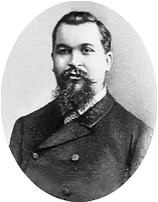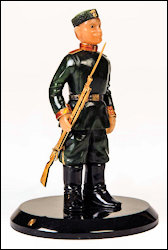- Pearls of Great Price: Fabergé Imperial Necklaces Presented in 1894 to the Future Empress Alexandra Feodorovna of Russia
- Fabergé Desk Clock Research
- Fabergé Research Tools in a Digital World: Archival Resources, Auction Records (1934 to the Present), Books and Journals, and Searching for Faberge Eggs

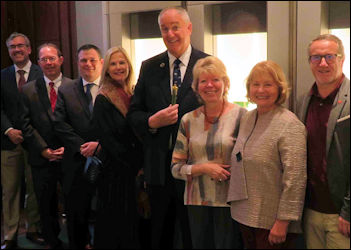
Book Signing
Gathering at Wartski, London
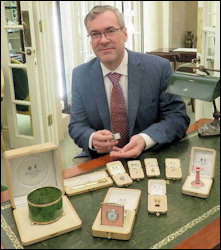
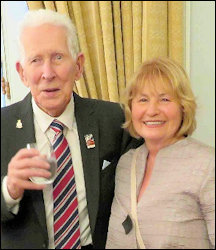
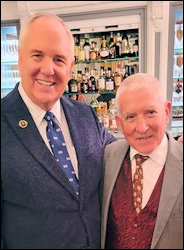
Appreciating Fabergé Objects at Bentley & Skinner, London,
Celebrating a Dedicated Fabergé Enthusiast (Age 94), Who Has Shared Fabergé News since 1998,
Fabergé Research Newsletter Authors Finally Meet in Person
(Photographs by Timothy Adams & Chad Solon)
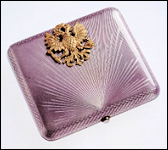
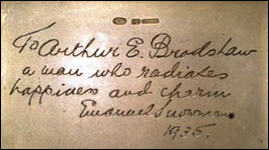
(A.) Holmström Cigarette Case with an Imperial Eagle and an Inscription on the Interior of the
Lid, “To Arthur E. Bradshaw, a man who radiates happiness and charm, Emanuel Snowman, 1935”.
(Keefe, John. Masterpieces of Fabergé: The Matilda Geddings Gray Foundation, 1993, pp. 68-69,
Dedication Photograph by Jane Allen with Courtesy of the Gray Foundation, New Orleans;
Case currently on loan to the Metropolitan Museum of Art, New York)
In the chapter entitled “The Collection”, Allen highlights Fabergé objects well-known to Fabergé enthusiasts over the ages based on Bradshaw’s detailed 1938 inventory on 50 typed pages. Major Fabergé objects known from the collection are the 1897 Coronation Box and its matching Coronation Coach Egg, both now in the Fabergé Museum in St. Petersburg, Russia, and two more eggs (1911 Bay Tree/Orange Tree Egg, and one questionable egg), hardstone flowers, ten folkloristic hardstone figures previously collected by Emperor Nicholas II and later known as the Sir William Seeds Collection, and a silver- gilt and gold enameled Fabergé cigarette case (A.) with a dedication by Emanuel Snowman, who oversaw the opening of the London Fabergé branch of Wartski’s in 1911. Included in Allen’s book are recollections from jewelry dealers, who have handled these pieces and research details provenance for the Fabergé eggs published in the Imperial Egg Chronology on the Fabergé Research Site.
During the research phase of the Bradshaw biography these publications appeared in print:
-
Munn, Geoffrey. Wartski – The First One Hundred and Fifty Years, 2015, includes colored illustrations of extant Fabergé objects from the Arthur Bradshaw Collection.
-
McCanless, Christel Ludewig, “Are the ‘Coronation’ Snuff Box and the Coronation Egg a Matched Pair? Fabergé Research Newsletter, Summer 2018.
-
“Readers Asking for Assistance!” Fabergé Research Newsletter, Summer 2018.
- Allen, Jane “The Impassioned Collector: Arthur E. Bradshaw (1879-1939).” Fabergé Research Newsletter, Spring 2020.
-
May 17, 2024 Heritage Auctions, Dallas (TX), Imperial Fabergé & Russian Works of Art. Five Faberge objects shown below were previously in the collection of Prince Vasilii Romanov (1907-1989), and details about the Nelkin Collection which is one of five collections under the hammer.
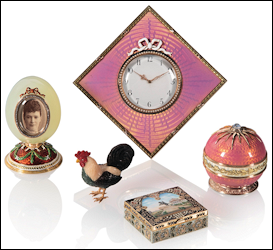
Prince Vasilii Romanov (1907-1989) Fabergé Objects
(von Habsburn, Geza, Fabergé in American, 1996, pp. 44-47;
Photograph Courtesy Hertiage Auctions, Dallas, Texas) -
September 27, 2024 Opening of a new exhibition with Fabergé objects on loan from the McFerrin Collection at the Houston Museum of Natural Science in Texas. The current venue will close July 7, 2024. A suggestion has been made to have an informal gathering of Fabergé enthusiasts to celebrate this milestone. For all the exciting details see “Houston, Texas. Houston Museum of Natural Science” entry in Exhibition & Museums.
-
Monograph about Fauxberge is under contract to be published in late 2024.
- Fabergé study of objects in the 1902 von Dervis Palace exhibition identified and compared to extant Fabergé pieces (Example of the detailed research: Battered Fabergé Survivors from the 1902 von Dervis Exhibition)
Presented in 1894 to the Future Empress Alexandra Feodorovna of Russia
The love story of the future Empress Alexandra Feodorovna (born Princess Alix of Hesse and by Rhine) and Nicholas Romanov began ten years earlier in 1884. The two first met at the wedding of Nicholas’ Uncle, Sergei Alexandrovich of Russia (1857-1905), and Alix’s sister, the future Grand Duchess Elisabeth Feodorovna of Russia (Ella, 1864-1918). Alix was 12 and Nicky 16 years of age when they first met. Their love relationship blossomed during Alix’s 1889 visit with her sister Ella in Russia. Nicholas wrote in his January 1890 diary, “It is my dream to one day marry Alix H. …”.1 Four years later in April 1894, his dream came true when Nicholas traveled to Coburg, Germany, with many precious betrothal gifts. Discussed in detail in this historical research study are a Fabergé sautoir (very long necklace, A.), the most expensive object ever made by the original Fabergé firm in Russia, and given to the bride by her future father-in-law, Emperor Alexander III (1845-1894), and a five-strand pearl necklace (B.) with a detailed object description found in an archival summary of a 2013 Russian publication2 identifying Alix the bride as the recipient.
Necklace of Pearls)
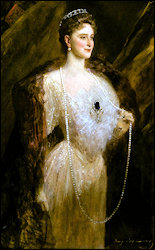
(A.) Before 1902 – Portrait of the
Empress Alexandra Feodorovna
by Jean-Joseph Benjamin-
Constant (1845-1902) Wearing
a Sautoir
(Collection of National Art
Museum of Azerbaijan,
Wiki Commons)
Ongoing project to identify
the lady in the portrait,
archival proof needed!
Pearl Necklace
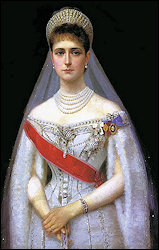
(B.) 1894 – Painting of Empress
Alexandra Feodorovna in a
Russian Court Gown by Ilya
Savich Galkin (1860–1915)
Wearing a Five-Strand
Pearl Necklace
(Ilya Savich Galkin,
Public domain,
via Wikimedia Commons)
Cost of Empress Alexandra Feodorovna’s Pearl Necklaces Engagement Presents:
| ITEM | 1894-95 | 2023 |
|---|---|---|
| (A.) Sautoir (Very Long Pearl Necklace, 1937 Interview with Agathon Fabergé, son of Carl Fabergé, and Published in 1949)7 | 1894: 250,000 Gold Rubles, Largest Fabergé Order Ever! | $6.87 Million |
| (B.) Five-strand Pearl Necklace (Dowry Inventory Record)8 | 1894-95: 171,600 Rubles | $4.72 Million |
Original Documentation 1894/first published in 1996

(C.) 1894/1996 Letter from Alix (Later Alexandra Feodorovna) to Her Future Mother-in-Law, Maria Feodorovna, Wife of Emperor Alexander III.
(Maylunas, Andrei, and Sergei Mironenko. A Lifelong Passion: Nicholas and Alexandra, Their Own Story, 1996, p. 55)
1911/2019/2024 (Published in The Project Gutenberg EBook and reprinted as a paperback with a January 3, 2024, date) As the Fabergé Research Newsletter research deadline approached, the authors discovered a photograph and a mention of the sautoir by the American writer Kellogg Durland (1881-1911). He had been commissioned by the Woman’s Home Companion to travel to Russia and to write about Empress Alexandra Feodorovna. In his 1911, Royal Romances of To-Day book, he writes at length about Empress Alexandra, and comments on the Tsaritsa’s fondness (D.) for pearls:

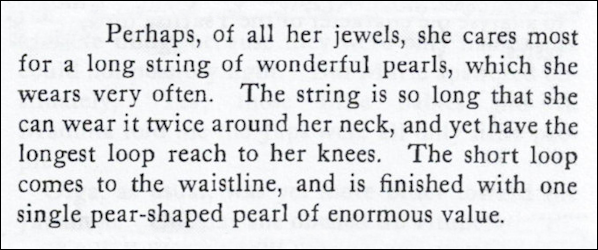
(D.) 1911/2024 The ‘Tsarita’ (Empress Alexandra Feodorovna) and Kellogg Durland’s description of the sautoir
in his book, Royal Romances of To-Day, 1911, pp. ii, 183, written after his return from Russia.

(E.) November 1937/1949 Agathon Fabergé Interview Quoted by Henry C. Bainbridge.11
Paintings and photographs:

(F.) Signed and Dated 1897 Painting
of Alexandra Feodorovna, Empress
of Russia by Heinrich von Angeli
(1840-1925) Commissioned by
Queen Victoria.
(Royal Collection Trust #404572)
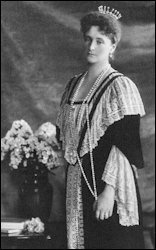
(G.) 1906 Empress Alexandra
Feodorovna with Her Sautoir
Pearl Necklace (Courtesy PICRL);
More Details in Kellogg Durland’s
Book Royal Romances of To-Day,
1911, pp. ii, 183 (D.)
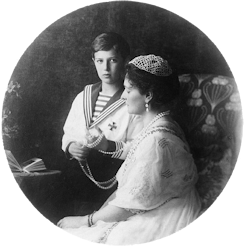
(H.) 1913 Empress Alexandra Feodorovna,
Wife of Emperor Nicholas II, and Their Son,
the Tsarevitch Alexei (1904-1918)
Playing with Her Pearls
(Wiki Commons)
The Internet websites, Alexander Palace Time Machine and Royal Magazin, address the possibility of the Imperial family, and especially, Alexandra Feodorovna taking most of her private jewels with her to Tobolsk in Siberia on the way to Ekaterinburg, Russia, where the Imperial family was brutally murdered in 1918. The Empress had some of her jewels hidden by a family valet who gave them to the Mother Superior of the Tobolsk Ivanovski Monastery for safekeeping. The discovered jewels were inventoried. Was the sautoir (G.) included in the 1933 Tobolsk List of Jewels (I.), and perhaps shown in the very few existing photos? Today the archives relating to the Tobolsk List are still closed to researchers.
A treasured gift from one of the authors of the 2013-2014 Moscow Diamond Fund Guide (J.) allows one to ask if the necklace possibly ‘last seen in a 1967 Kremlin exhibition‘ is a match to the pearl necklaces (A. – B.) discussed in this research effort.

(I.) 1933/1996 1933 Tobolsk List of Jewels with Pearl Necklaces
(Courtesy Alexander Palace Time Machine)

(J.) Borodychyova, Irina, and Irina Polynina. Diamond Fund Guide – Moscow, 2013-2014, pp.1, 134-135
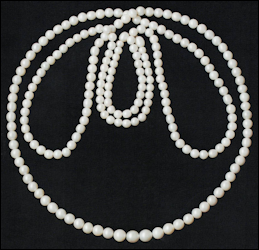
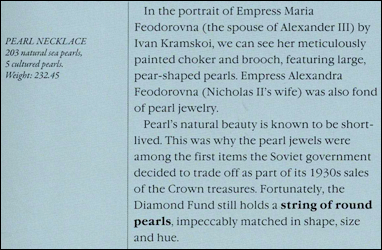
Pearl Necklace, 203 Natural Sea Pearls, 5 Cultured Pearls, Weight: 232.45.
There is no identification to Alexandra Feodorovna nor the date of the necklace.
- Timms, Elizabeth Jane, “The Personal Jewellery of the Last Tsarina, Alexandra Feodorovna”, Royal Central, August 14, 2018.
- Timms, Elizabeth Jane, “A Pearl Earring and Imperial Russia”, Royal Central, November 20, 2018.
-
A La Vieille Russie, The Empress of Gems – Pearls, June 1, 2020.
Unfortunately, data without sources and unverified facts are also on the Internet.12
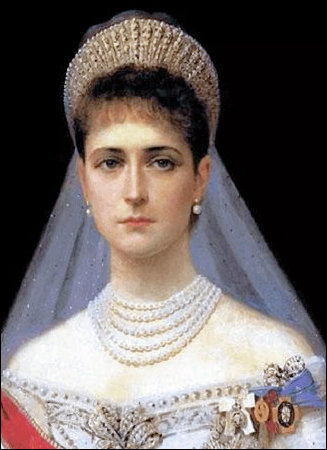
(B.1) 1894 – Close-up of Empress Alexandra Feodorovna, Wearing
Her Wedding Five-strand Pearl Necklace by Ilya Savich Galkin
(1860-1915).
(Ilya Savich Galkin, Public domain, via Wikimedia Commons)

Alexandra Feodorovna’s Office
“Requested in April 1895 and Received in May 1895″.
(Zimin, Igor, and Alexander Sokolov, Jewelry Treasures
of the Russian Imperial Court, 2013, p. 81)
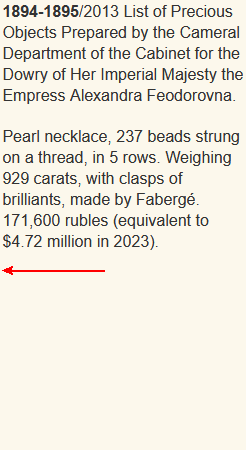
The authors thank Zvezdana Ster (Slovenia)
and Cynthia Coleman Sparke (UK)
for their translation assistance.
1 Massie, Robert. Nicholas and Alexandra: The Last Imperial Family of Tsarist Russia, 1998, p. 49 (Wiki Commons)
2 Zimin, Igor, and Alexander Sokolov. Jewelry Treasures of the Russian Imperial Court, 2013, p. 81.
3 Kunz, George F., and Charles H. Stevenson H. The Book of the Pearl, 1908, p. 358.
4 L’École Van Cleef & Arpels, “Pearl Merchants: The Forgotten History of a Trade between the Gulf and France“.
5 Kunz and Stevenson, p. 80.
6 Cartier Brickell, Francesca. The Cartiers, 2019, pp. 136-7.
7 Bainbridge, Henry Charles. Peter Carl Fabergé: Goldsmith and Jeweller to the Russian Imperial Court and the Principal Crowned Heads of Europe, 1949, p. 56.
8 Zimin, Igor, and Alexander Sokolov. Jewelry Treasures of the Russian Imperial Court, 2013, p. 81.
9 The Uncle (Der Onkel in German), a term of endearment for Alexander III.
10 Fabergé, Tatiana, and Valentin Skurlov. The History of the House of Fabergé According to the Recollection of the Senior Work Master of the Firm, Franz P. Birbaum, 1992, p. 24.
11 Bainbridge, Henry Charles. Peter Carl Fabergé: Goldsmith and Jeweller to the Russian Imperial Court and the Principal Crowned Heads of Europe, 1949, p. 56.
12 This website suggests the two necklaces cost more than 345,000 rubles. The more correct amount based on the discovered archival documentation in this study appears to be 250,000 good rubles for the pearl sautoir plus 171,600 rubles (also cited incorrectly as 177,600 in other sources) for the five-strand pearl necklace.

Henrik Wigström
(active 1903-1917) inherited the
Perkhin workshop after the death
of his colleague and friend.
(Photograph Courtesy Ulla
Tillander-Godenhielm1)

(A.) Wigström – Silver Clock, London Sales Ledgers
for January 8, 1916, Stock Number 21896
(von Solodkoff, front flap of book jacket & p. 42)
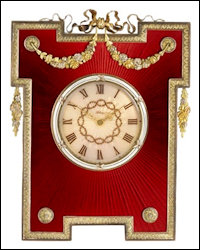
(B.) Wigström – Gold, Silver-Gilt and
Enamel Desk Clock, 1913 London Import
Mark, Stock Number 30?949 [sic]
(Sotheby’s London, October 18, 2017,
Lot 138, Sold for 143,750 GBP,
Ruzhnikov, pp. 18-21)
(A.) von Solodkoff, Alexander. Fabergé Clocks, 1986, contains a “fascinating source of information – the sales ledgers of Fabergé’s London branch which cover the period from 1907 to 1917. During this time a total number of 70 clocks are recorded in the complete list … published here for the first time.”
Chapter by Alexander von Solodkoff entitled, “Desk and Table Clocks by Fabergé during the Late Years of the Empire” in the 2023 Ulla Tillander-Godenhielm monograph3 includes 15 clock drawings for the years 1912-1917 from the Henrik Wigström studio along with the clock, if extant.
(B.) Andre Ruzhnikov’s Flipbook website publication, Fabergé Works of Art – The Clock Collection, pp. 1-99, summarizes 40 clocks profusely illustrated and described by the London dealer.
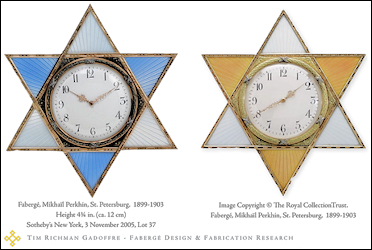
(C.)
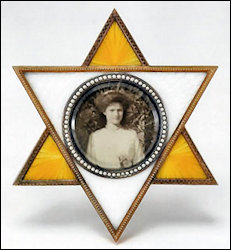
(D.) Frame with an Original Photograph of Grand
Duchess Tatiana, Daughter of the Imperial Pair,
Nicholas II and Alexandra Feodorovna
(Courtesy Pratt Collection)
Yellow and White Enameled Clock (right). Inherited by Prince Philip, the Duke of Ediburgh in 1965. The prior provenance is stated in de Guitaut, Caroline. Royal Fabergé, 2011, pp. 136 and 142.
James Hurtt (USA) has found, based on invoices for Alexander III and Maria Feodorovna purchases, the Perkhin workshop began making enameled clocks in 1892.
(D.) Similar Perkhin Frame with an Original Photograph of Grand Duchess Tatiana Mounted in Pearls, Stock Number 55135. Frame is featured in the Fabergé Research Newsletter, Summer Special Edition 2011 – “A star-shaped frame by Mikhail Perkhin now in the Pratt Collection was with the Imperial family during their imprisonment in the ‘House of Special Purpose’ of the Siberian town of Ekaterinburg. Its story is told in a research essay, A Silent Witness: The Hidden Treasure of a Fabergé Frame by Kieran McCarthy of Wartski.” (More details in von Habsburg, Géza, Fabergé Revealed at the Virginia Museum of Fine Arts, 2011, pp. 224-225.)
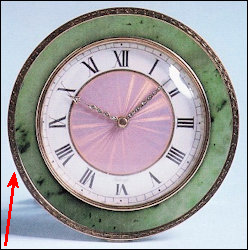
(E.) Desk Clock with Stock Number 25361,
Henrik Wigström (active 1903-1917)
(Sotheby’s Geneva, May 16, 1991,
Lot 276, 88,000 Sw Fr.)

Freddie Mercury:
A World of His Own | The Evening Sale
(Sotheby’s London, September 6, 2023, Lot 4,
GBP 69,350/$86,300)
The nephrite ring shown in the 2023 auction lot (E. right) is not secured in the same location to match the 1991 auction illustration (E. left) which unfortunately has a camera light source reflection on the glass covering the Roman numeral II. Perhaps this occurred in a cleaning or restoration process.
Timothy Gadroffe on his website discusses the “Fabergé” desk clock (E. right), and newsletter readers agreed with his conclusion:

(F.) Cartier Resources
(Courtesy of Christie’s Geneva, A Lifetime of Collecting – 101 Cartier Clocks, July 7-20, 2020;
Francesca Cartier Brickell, The Cartiers: The Untold Story of the Family Behind the Jewelry Empire, 2019)
A group of Fabergé enthusiasts is studying triangular Fabergé clocks connected to the first case study above, and will report their findings when completed. Readers are encouraged to share additional examples, and advise, if there are other in-depth clock studies not mentioned in this brief summary: Christel McCanless
1 Tillander-Godenhielm, Ulla. Fabergé, The Twilight Years: Drawings and Objects from the Second Henrik Wigström Album, 2023, p. 16.
2 Clocks (including clock eggs) discussed in Fabergé Research Newsletter issues – Summer 09 | Winter 09-10 | Spring 10 | Summer 10 | Summer 11 (Special Edition) | Fall 11 | Fall 12 (Tim Richman Gadroffre studied nephrite clocks by Henrik Wigström with production and inventory [stock] numbers in “Variations on a Theme, Part II: Clocks”) | Spring 15 | Spring 23
3 Tillander-Godenhielm, Ulla. Fabergé, The Twilight Years: Drawings and Objects from the Second Henrik Wigström Album, 2023, pp. 169-179.
Books and Journals, and Searching for Fabergé Eggs
Resources:
-
Contact the leading Fabergé dealers in the United Kingdom and the USA listed on the Fabergé Research Site.
-
Learn from the published literature about the original jewelry firm in Russia and its exquisite creations.
-
Study the Fabergé Research Newsletter beginning its 16th year of publication in 2024.
-
Learn about marks on objects and compare them to the accepted norms for hallmarking silver and gold pieces in Imperial times. Do your own research using reference tools:
Tillander-Godenhielm, Ulla, et al. Golden Years of Fabergé: Drawings and Objects from the Wigström Workshop, 2000. Documentation of Fabergé techniques was scarce until the recent discovery of an album with more than 1,000 drawings from the workshop of Henrik Wigström, Fabergé’s chief work master from (1903-1917). Objects, which have been identified, are reproduced next to the original drawings. Monograph published in a slipcase accompanied an A La Vieille Russie exhibition of over 100 finished objects including loans from the Royal Collection of Thailand. A second research study, Fabergé: The Twilight Years, is a companion volume to The Golden Years of Fabergé (2000), both of which reveal production drawings from Fabergé’s main workshop.
-
Practice Caveat Emptor as a seller and/or a buyer.
Research methodologies and tools are hard copy materials (books and journals, auction catalogs) vs. digital resources, including social media which cannot be used in a scholarly art history publication due to copyright and permission restrictions. Seasoned curatorial staff and auction house catalogers have retired and the impact of modern imitations present the younger generation of curators, catalogers, and new collectors with a steep learning curve when examining the expensive real Fabergé vs. the modern make-believe objects so prolific on the internet. Bleeding into auctions offerings are private retail sales offered by the major auction houses (GOLD-MOUNTED NEPHRITE TRAY by Henrik Wigström, Fabergé workmaster, active 1903-1917).
A short summary is attempted below from my experience as a librarian, published two Fabergé reference books, and editor and publisher of the Fabergé Research Newsletter for 15 years. Oversights and new additions are valuable additions to keep research efforts for authentic Fabergé alive: Christel McCanless
-
Original Fabergé invoices in the Russian State Historical Archive (RGIA) in St. Petersburg, the largest archive in Europe with more than 7 million items, of which 6.5 million are documents on the history of the Russian Empire.
-
Guzanov, A. and R.R. Gafifullin, Fabergé Items of Late XIX – Early XX Century in the Collection of the State Museum of Pavlovsk, 2013. First full publication about 34 Fabergé items belonging to members of the Imperial family now housed in the Pavlovsk Palace Museum. The book’s appendix contains a chronological list of purchases made by members of the Romanov family from the St. Petersburg and London branches of the firm. The Fabergé objects in the museum collection are not detailed on the Internet, except for the extant Fabergé bodyguard1. In Russian.
-
Tatiana Fabergé (1930-2020), great-granddaughter of Carl Fabergé, donated her Fabergé Family Archives to the Kremlin Armory Museum in Moscow. At press time, they are not available because of an anticipated move to a new building … “located on Red Square in 2024. The new K5 museum – which has been under construction for nearly a decade – will feature a ‘large Fabergé Hall‘ to showcase the 10 Imperial Easter Eggs and other Fabergé items from the museum’s collection.” (Information shared by Paul Gilbert, UK, and Valentin Skurlov, Russia)
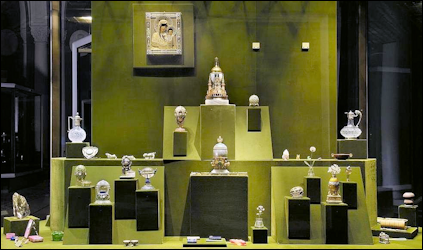
CLICK THE ABOVE PICTURE FOR A LARGER VIEW
Current Fabergé Display Case in the Kremlin Armory Museum in Moscow
(Press Release Published by Paul Gilbert, July 28, 2023)
Archival collections preserved in the Fabergé Museum in St. Petersburg:
-
Henry Charles Bainbridge (1873 or 1874, died 1954), employee and manager of the London Fabergé branch from 1906-1917.
-
Forbes Magazine Fabergé Collection begun in 1965 by Malcolm Forbes (1919-1990), publisher of Forbes Magazine, was sold in 2004 to Viktor Vekselberg (1957- ), Tyumen Oil Company (TNK), Russia. The objects in the collection and the archives donated at a later time are the nucleus of the Fabergé Museum which opened on November 19, 2013.
Questions – Are the archival papers from the late Dr. Marina Lopato, Fabergé Specialist in the Hermitage Museum, who was instrumental in making the virtual tour of the Hermitage Fabergé venue possible, open for research?
USA – Libraries and/or curatorial files for original collectors:
-
Matilda Geddings Gray Collection inherited by her niece, Matilda Gray Stream, who just died2 at age 99 on October 14, 2023. At press time, the Gray Collection is on view at the Metropolitan Museum of Art, New York City. A fledgling effort is underway to catalog Fabergé objects owned by the Metropolitan for website access.
-
India Early Minshall Collection, Cleveland Museum of Art (Ohio)
-
Marjorie Merriweather Post Collection at Hillwood Estate, Museum & Gardens, Washington (DC).
-
Lillian Thomas Pratt Collection, Virginia Museum of Fine Arts, Richmond, Virginia. One-of-a-kind 360° views of the eggs are a treat!
-
Royal Collection Trust, London (UK) with an elegant and comprehensive website is still a very active work in progress with new features.
Questions – Caveat Emptor! The Afterlife of Fabergé: Fauxbergé and More, an online-lecture by Karen Kettering sponsored by the Russian History Museum in Jordanville (NY), includes an informative discussion of Armand Hammer’s use of his loose-leaf advertisements – without dates and undocumented provenances – randomly inserted into card-stock folders for ever-changing sales in department stores. More research to be published.
What happens to the archives when a Fabergé collection like the Brooklyn Museum of Art is sold at auction (1.) Sotheby’s London, Fabergé & Vertu: Property from the Brooklyn Museum, Sold to Support Museum Collections, December 2, 2020, and (2.) Christie’s London, A Selection of Fabergé Masterpieces from the Harry Woolf Collection, November 29, 2021?
Scipio is “the only online database of auction catalog holdings in existence with these features – over 570,000 records updated daily from the 16th century to auction not yet been held”. It is a listing of auction catalogs retained by libraries worldwide.
Auction catalogs and books relating to Fabergé are available for purchase from Fabergé dealers, new and used book dealers co-operative like Abebooks, and reference access from museum libraries where permanent collections are, or temporary exhibitions have been in the past. Jeff Eger, a specialized auction catalog dealer, sells catalogs and keeps one master reference copy for provenance research upon request.
The Fabergé Research Site has a listing of Fabergé books with brief annotations from 1930 to 2023.
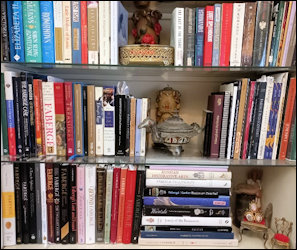
(A.)
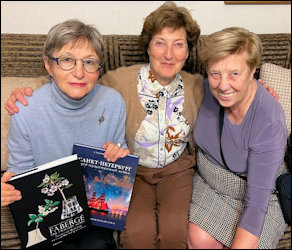
(B.)
(B.) Authors sharing their recent publications about Fabergé as well as the history and architecture of St. Petersburg from 1990’s to the present with some details about the Fabergé Museum which opened in 2013. (Photograph Courtesy Ulla Tillander-Godenhielm)
-
Fabergé, Tatiana, Proler, Lynette G. and Valentin V. Skurlov. The Fabergé Imperial Easter Eggs, 1997. Letters written by Tsars Alexander III and Nicholas II, Fabergé invoices, cabinet documents and Bolshevik inventories are the basis for new research by Valentin V. Skurlov of St. Petersburg. This information sheds new light on the history of the Fabergé eggs.
-
Lowes, Will, and Christel Ludewig McCanless. Fabergé Eggs: A Retrospective Encyclopedia, 2001. Monograph gives comprehensive information about 66 Fabergé eggs divided into four categories – Tsar Imperial, Imperial, Kelch and Other. Technical descriptions, all known public exhibitions and auctions through 1997, and reference citations (books, journals, newspapers, and miscellaneous sources) covering the literature of nine countries are given for each egg. Who’s Who in the House of Fabergé profiles 500 artisans and companies who worked for or with Fabergé.
-
Fabergé Imperial Egg Chronology – Egg descriptions, background notes, and provenances updated from Lowes, Will, and Christel Ludewig McCanless, Fabergé Eggs: A Retrospective Encyclopedia, Scarecrow Press, 2001. Updates are also available in the Fabergé Research Newsletter Index.
-
Fabergé Eggs, a website by our colleague, the late Annemiek Wintraecken, contains excellent historical data.
With endless support and dedication to the task the exhibition and museum websites on the Fabergé Research Site segments have been reviewed by Riana Benko for additional details. The results have been uploaded to the refreshed Exhibitions & Museums section with the publication of this newsletter.
Are there other virtual tours like the Fabergé Collection in the General Staff Building (#301–302), Hermitage Museum in St. Peterburg, featuring a permanent display began by the late Marina Lopato (died 2020). Readers aware of corrections or additions for this project, please share: Christel McCanless
1 “Fabergé Cossack Figures Created from Russian Gemstones” by Timothy Adams and Christel Ludewig McCanless. (Peer reviewed article published in Gems & Gemology, scholarly journal of the Gemological Institute of America, Carlsbad, California, and referenced here with permission of the publisher.) Fabergé Research Newsletter, Winter 2016.
2 Obituary of Mrs. Stream.
Timothy Adams (USA), Changing World of Fabergé Auctions and the Ivory Trade Law, Part I
Christel Ludewig McCanless (USA), Changing World of Fabergé Auctions, Part II
Objects in the style, in the art, or in the taste of Fabergé are sometimes described as ‘modern’ Fabergé objects but not identified as imitations, or objects which do not use the traditional materials and hand-crafting techniques known to Fabergé connoisseurs. All non-traditional Fabergé objects require a closer look at stylistic patterns, materials used, knowledge about Fabergé objects made, and a heavy dose of Caveat Emptor before bidding!
Highlights of Original Fabergé Lots Sold at Auction:

case by Fabergé, St. Petersburg, circa 1910,
scratched inventory number 21443.
Sold $163,800
The Collector: New York, Lot 512 – Shared by
James Hurtt, USA)
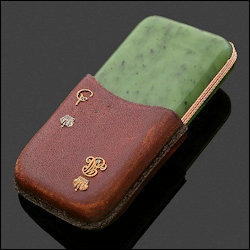
with monograms in gold, Grand Duke Wladimir
Alexandrovitch of Russia (1847-1909) (partly
missing) and his wife, Grand Duchess Maria
Pavlovna (1854-1920). St. Petersburg, circa
1890, Goldsmith: Michael Perkhin.
Sold € 3,400
A French Private Collection, Archaeology,
Weapons, Historical Memorabilia,
Far East, Lot 431)
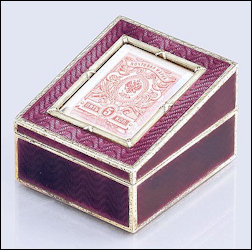
box, workmaster Henrik Wigström, St. Petersburg
1908-17, scratched inventory number 6110A.
Sold 135,000 SEK
Ceramics & Works of Art, Lot 299, Shared by Ulla
Tillander-Godenhielm, Finland)

Auction Lot Review: Extensive condition report, identified as “in the taste of Fabergé”, no visible hallmarks. Sold for CHF $1,000, same as the low estimate stated before the sale. Authentication Criteria by Tim Richman Gadroffre includes four basic elements needing particular attention when assessing credentials for a Fabergé clock:
- Clock hands
- Rear cover, where assay & makers’ marks are found, and the strut
- Clock movement,
- Presentation case, if present.
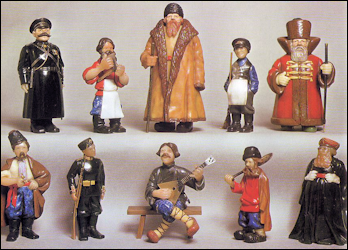
(E.) Original Fabergé hardstone Figures are never on a stand!
Authentic!
Formerly the Arthur Bradshaw Collection
Sir William Seeds Collection, Exhibited in London, 1973
(Courtesy Wartski)
1 Henrik Wigström Fabergé Neprite Tray for sale at Christie’s.
2 Sotheby’s Fee Structure, Feb 1, 2024.
(Updates are posted in Exhibitions on the Fabergé Research Site)

Fabergé Silver and Sandstone Elephant
(Courtesy A La Vieille Russie, New York)
-
Everyday Fabergé, the current McFerrin Collection venue at the Houston Museum of Natural Science in Texas will close on July 7, 2024, and re-open with a new selection of objects from the 600 Russian and Fabergé objects on September 27, 2024. Perhaps a perfect time for an informal gathering for Fabergé enthusiasts?
-
Katrina Warne (UK) discovered Fabergé objects on view at the Royal Treasure Museum in Lisbon, Portugal.
- Andre Ruzhnikov, Russian art dealer in London, is interested in lending Fabergé objects from his collection to a museum for a temporary venue.
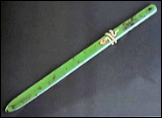

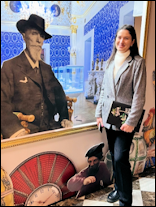
UPPER LEFT: Nephrite Paper Knife by Mikhail Perkhin, Lisbon, Portugal. The Royal Treasury
LOWER LEFT: Traveling Collection on View in the USA, New York City, New York. Metropolitan Museum of Art
RIGHT: Special Welcome to the New Deputy Director, Fabergé Museum in St. Petersburg
If your favorite museum collection is not listed, we look forward to hearing from you: Christel McCanless

